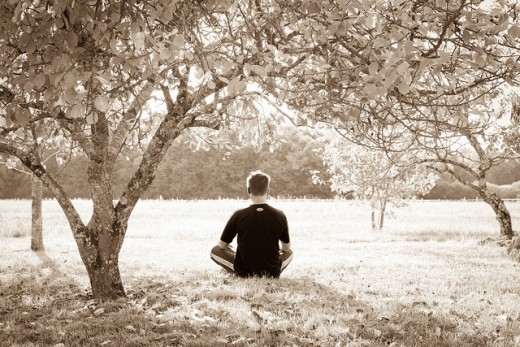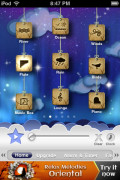The Basics of Effective Meditation

Introduction
Do you find yourself struggling with stress? Do you feel overwhelmed at times? Do you wish that you could just 'disconnect' and get a bird's-eye-view of your life?
You're in good company. Many people feel this way. The idea that you can 'disconnect' from your life and see it from above might seem like something out of science fiction, but you can do so quickly and easily using a few small tricks.
In just minutes a day, you can:
-Feel better and more relaxed.
-Take complete control over your life.
-See your life from a bird's-eye perspective, giving you the power and foresight to make good decisions.
-Take control of your emotions, allowing you to operate better under pressure and improve your relationships with friends, family and colleagues.
In this article, you're going to learn the basics of how to 'unplug' from your life, empowering you to return to it feeling refreshed, reinvigorated, and in-control.
Create a Space to Meditate
Your first priority is to establish a space where you can meditate. Ideally, this space is free from noise and distraction. You also want this to be in a space that isn't already associated with another activity. For example, you want to avoid using the chair or sofa in front of the television to meditate, as you already associate that location with watching television.
Consider a corner of a room that sees little use. Sit on a pillow on the floor, if necessary. You'll want to be comfortable. If possible and safe to do so, consider creating a space outdoors.
In this article, we'll be using a cognitive bias known as psychological anchoring to our benefit. In short, we'll be creating 'anchors' in our meditative space in order to allow the meditative benefits to bleed into the rest of our lives. We do this by engaging the five senses.
SCENT
For scent, you'll want to pick up a candle from your local retailer. You'll want to make sure this is a candle you've never used before, and with an aroma you find pleasing. This candle is only to be used while meditating, as with repeated use you'll 'anchor' that smell to a feeling of relaxation and control.
Additionally, you'll want to avoid using this candle outside of the meditation chamber. This is because you want it anchored specifically to meditation. Using it outside of the chamber means that you'll be anchoring it to a different activity, which dilutes its effectiveness. Instead, put this candle in a safe space and only bring it out when you're intending to meditate.
SOUND
To engage your sense of sound, use a calming song, preferably one without lyrics. See the content box below for an example. Like with the candle, you want this song to be one that you'll only be listening to while meditating. Use of a CD or Mp3 player is ideal, however you can also pull up a Youtube window and play the song that way.
TOUCH/FEELING
Make sure the temperature in your meditation space is to your liking. If you prefer a warmer temperature, turn up the heat. If you prefer a cooler temperature, turn up the air conditioning. This may require some experimentation, as you'll not want to have the temperature too hot or too cold, and because you'll be sitting completely still, you're more likely to notice the temperature than if you were up and walking around.
If you're meditating inside, consider using a chair that sees little use. If you're on the floor or sitting against the wall, sit on comfortable pillows, and place comfortable pillows between your back and the wall. If you're outside, be sure to find a place that is free of insects such as mosquitoes, and choose a specific blanket or towel that you'll only use while meditating.
SIGHT
Sight is a relatively easy sense to implement for the most part -- your eyes are closed!
However sight can still be used to your benefit. Part of meditation is putting yourself in a specific head space. You want to take yourself OUT of your normal head space (which is created by your usual surroundings -- lighting, decorations, etc.) and INTO a head space of your design. If you're inside, turn the lights down or turn them off completely. Try to remove all sources of unnatural light, relying instead on the candlelight. If you're using a computer for music, use a sheet to cover the screen.
When you first start meditating, this "change of scenery" will clue your mind in. Your mind will say "something about this is different". It will then pay close attention to the minutes that follow. With repetition, your mind will start getting the hint. It will recognize your surroundings and prime itself to go into your meditative state automatically. This process is known as classical conditioning.
If your meditative state is outside, consider going at the same time each day or night, and again, always go to the same place. Doing so will have the same conditioning effect -- your mind will see your surroundings and realize "it must be meditation time".
TASTE
Taste, like sight, operates more as a conditioning device. You don't want to be eating or drinking while meditating, as doing so will distract you. Instead, consider drinking a cup of tea or juice before entering your meditation chamber (avoid caffeinated beverages like coffee or soda). Like with candles and whatever you used for touch/feeling, you'll ideally want to stick to something that you're ONLY going to drink when preparing to meditate. That way, you are conditioning your mind to go into a meditative state more easily.
By incorporating all five of your senses, you are 'anchoring' your mind in your meditation chamber. Over time, you will find that everything in your life is influenced by your meditation. And because you're calm and in-control while meditating, this means that this calmness and control will permeate through your life.
To engage your sense of sound, use a calming song, preferably one without lyrics.

Create Ideal Circumstances
Before you meditate, you'll want to make sure that your environment is conducive to relaxation in order to maximize the effectiveness of your meditation. Be sure to:
-Turn off your cell phone and leave it in another room.
-Turn off the television.
-Lock the doors.
-Ensure that nobody will come along and interrupt you.
As your meditative abilities grow, there may come a time that you feel the need to employ aromas or background music. That being said, for now they're unnecessary. Your objective here is simply to enter into a meditative state and remain there for several minutes. Details like aromas and music are better suited for intermediate meditation, when you're specifically aiming to create a particular mindset.
If possible to do so, consider bringing an alarm clock. If you do use an alarm clock, please refrain from using the one on your cellular device. This is because doing so requires you to bring the phone into the space with you. In these early stages, the bleeps and buzzes your phone makes can be distracting and you might be tempted to stop meditating and play with your phone. For that reason, you're better off using a standard digital alarm clock, such as one that can be purchased at an inexpensive price from your local retailer.
Meditating
Check your location to make sure you feel comfortable. Use this time to double-check your surroundings to make sure that you've dealt with possible distractions.
If you live in a heavily populated area such as an apartment building, you might hear your neighbors from time to time. There is little you can do to change this. This is fine; part of meditation is being aware of these things. As you practice, you'll find that distractions such as neighbors or traffic or dogs barking outside are no longer irritating but actually benefit you.
If you're using an alarm clock, set it for around ten minutes (add a couple of minutes if possible, to accommodate the "getting comfortable" phase).
Now sit or lay down in your chosen location. Closing your ideals is preferable, but if you find that doing so makes you feel uncomfortable, only close them about halfway so the world appears blurry.
Now, pay attention to your breathing. You want to fill your lungs and exhale fully. Breathe slowly, taking in plenty of oxygen and expelling it in a rhythmic manner.
The more you focus on your breathing, the more you'll find that your mind seems to become quiet and clear. The "movie" in your mind's eye goes dark. From time to time, other thoughts will enter into your mind. It is here that you realize that thoughts are only as powerful as you make them.
When you pay attention to a thought, it increases in size. The more you pay attention to it, the bigger it gets. The less you pay attention to it, the smaller it gets. Eventually, it disappears.
When you first begin, you may find that old habits take over and you find yourself paying attention to these thoughts. When you find yourself doing so, please be kind to yourself. Recognize that you've allowed your mind to become distracted and focus on your breathing once again.
Thoughts, emotions, and external stimuli (such as the neighbors) all operate on these principles. The more you pay attention to them, the more you become engaged to them. Give them less power, and they have less power over you.
Be aware that you're not 'blocking out' or 'ignoring' these stimuli. You're simply acknowledging their presence and allowing them to pass without engaging with them. In doing so, you realize that these various forms of stimuli aren't as important as your mind initially believed. Much of this stimuli is inconsequential.
Continue breathing, and continue focusing on your breathing. Again, take deep breaths in and exhale. There's no rush. If you start to feel antsy or like you've been meditating for a long time, simply acknowledge these feelings and let them pass.
Continue focusing on your breathing until your alarm activates, or until you feel you can no longer focus on your breathing.

After Meditating
When you return to your normal life, you will notice the effects of meditating immediately.
You'll notice that you have a sense of "solidness" and that you feel compelled to move at a slower pace. You'll notice that the hundred things that demanded your attention previously no longer seem as pressing. You'll feel better about prioritizing and getting done the things that need to get done. Because you're better able to prioritize, you'll find that you're able to improve your circumstances with twice the effectiveness and half the work.
In short, you have taken a step toward streamlining your life.
Do this daily and you'll find that you'll quickly take complete control over your life, addressing the stimuli that require your attention and dismissing those that offer little benefit.
Summary
In this article, you learned:
-How to establish a quiet space, free of distraction, where you can "unplug" from your life.
-How to get rid of distractions in order to maximize your meditative session.
-How to enter into a meditative state by breathing deeply and focusing on your breathing.
-How to maintain your meditative state by acknowledging external stimuli and letting them "pass", rather than trying to block them out of your awareness.
-What to expect after you've completed your meditation.






